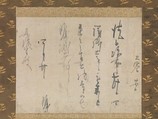Returned to lender The Met accepts temporary loans of art both for short-term exhibitions and for long-term display in its galleries.
Invitation Letter to a Banquet
Fujiwara Akisuke Japanese
Not on view
Despite the brevity and perfunctory nature of this missive, like an email of modern times, the energetic, free-flowing movement of the brush across the fine-quality paper is a reminder how, in ancient Japanese court culture, the medium was an essential part of the message. The more recent mounting of the letter as a hanging scroll only enhances its aesthetic effect.
The heading reads taikyō (great banquet), which in this case refers not to the palace New Year’s banquet but to one celebrating the appointment of a new minister (Daijin no taikyō ). The year, however, is not specified, so the recipient of the letter cannot be determined with certainty.
This is the only known surviving letter by Fujiwara no Akisuke, a prominent courtier-poet of the late Heian period. He signed his name in
an illegible cipher, with two characters rendered in hypercursive script. The letter reads:
Reception for the newly appointed minister. Twenty-seventh day. The date is now officially designated. Though I should have contacted you in person, because it too late now, I am sending this note.
To the Honorable Governor of Tango Province, on the twentieth day of the fourth month
Respectfully yours, Akisuke
This image cannot be enlarged, viewed at full screen, or downloaded.
This artwork is meant to be viewed from right to left. Scroll left to view more.



